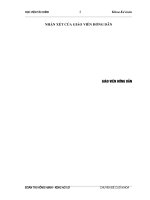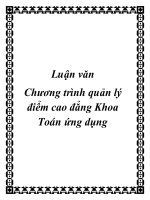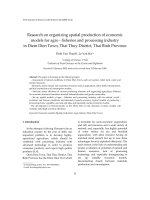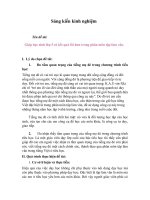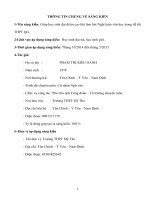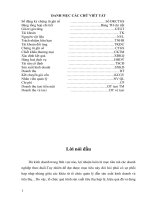CLOCK AND WATCH ESCAPEMENT MECHANICS ĐIỂM CAO
Bạn đang xem bản rút gọn của tài liệu. Xem và tải ngay bản đầy đủ của tài liệu tại đây (984.35 KB, 87 trang )
CLOCK AND WATCH ESCAPEMENT MECHANICS
Mark V. Headrick (Copyright 1997).
Section 1: Clock Escapements.
1: Efficiency and Power Losses. Page 4
2: Drawing an Escape Wheel. 5
3: Drawing the Graham Pallets. 6
4: The Graham Explained. 8
5: The Importance of the Simulation. 11
6: The Recoil Escapements. 16
7: The Brocot Escapement. 18
8: The Pin Wheel Escapement. 19
9: Other Design Considerations. 20
10: The Graham Reconsidered. 22
11: Efficiency in Numbers. 23
The first nine chapters are explained without math. These chapters are less
complicated, and they introduce the reader to the logic behind the drawing techniques, so
as to serve the needs of those who want to learn about escapements but would not be
drawing them on their own computers. The tenth chapter explains the math behind the
previous chapters. This way the reader has the option whether or not to become involved
with the math.
References:
Britten's Watch & Clock Maker's Handbook, Dictionary and Guide (1978 Edition).
Donald de Carle: Watch and Clock Encyclopedia (1977 Edition).
Henry B. Fried: The Watch Escapement (1974 Edition).
View animations of the escapements in this book on my website at
/>
1
Section 2: Watch Escapements. Page 41
12: Drawing the Club-Tooth Escape Wheel. 44
13: Drawing the Pallets. 50
14: Changing the Design. 53
15: Improving the Design. 57
16: The English Lever. 60
17: The Pin Pallet Escapement. 61
18: The Cylinder Escapement. 63
19: The Duplex Escapement. 67
20: The Chronometer Escapement. 72
21: Daniel's Independent Double-Wheel Escapement. 79
22: The Double-Roller.
Chapters 12 to 18 are similarly presented in order to introduce the reader to the
logic behind the drawings, though these drawings are more involved and require some
understanding of watch theory, such as lock, drop, draw, and impulse. Chapter 19 and
beyond become more involved with the math that is required to create the drawings. The
reader who does not want to become involved with the math could benefit from the logic
of the latter chapters by passing over the math.
I would like to thank the following for their invaluable assistance and encour-
agement:
Daniel Henderson Cecil Mulholland
Roy Hovey Steve Conover
Nino Gonzales Harry and Sue Wysong
2
Introduction. Graham escapement
Discover how much more there is Strip-pallet recoil
to know about escapements by creat-
ing your own drawings. The purpose
of this project is to introduce the
reader, whether professional or hob-
byist, to a hands-on method for draw-
ing a mechanical clock or watch es-
capement. While it is more obvious
that a manufacturer needs to know
how to design a pallet, the repairman
could do a better repair with an im-
proved understanding of design the-
ory. The ability to draw an escape-
ment enables one to experiment more
easily with the effects of changing the
variables and to compare different
types of escapements, their similari-
ties and differences.
The most important reason for
careful attention to design is effi-
ciency. The escapements most fre-
quently encountered at the bench are
the Recoil, the Graham (or
dead-beat), and the Swiss Lever.
These all have efficiencies below
50%. This means that more than half
the power is lost in the escapement
alone, after all the power losses in the
gear train.
modern
Swiss
Lever
These drawings are not dissimilar to what I
have seen in escapement literature. They do not
reveal the methods by which they were de-
signed, why the lines and curves are positioned
so. If these drawings ignite your curiosity, this
project is for you.
3
1: Efficiency and Power Losses.
A clock is usually taken to the shop for repair because the clock fails to keep
running. It runs for a while and stops because not enough power reaches the pendulum to
keep it running. One way to get it running is to double the weight, but this causes enor-
mous wear and consequent damage in the long run. The other way is to overhaul the
clock. The job of the repairman is to do whatever is necessary to minimize the power
losses between the weight and the pendulum. The clock is cleaned. Pivots are polished.
Worn bushings are replaced. Adjustments are made to the escapement to improve its
action. The clock is carefully lubricated. Other repairs are made as needed. These all
have the ultimate goal of reducing power losses.
There are two kinds of power losses in a clock: frictional losses and losses caused by
the action of the escapement (which result in additional frictional losses). Frictional
losses are easily understood. The lubricant has failed, causing drag. The bushings are
worn, so the gear and pinion teeth grind together. The pivots are scored, causing
frictional losses from rough surfaces. Dirt particles become imbedded in the worn
bushing, causing binding of the pivot, and so on.
Power losses caused by the action of the escapement are less obvious. The following
reasons are explained in detail in subsequent chapters. If the escape wheel rotates clock-
wise, the force it exerts on the pallet would be in a different direction to that of the
pallet's movement. The greater the angle between the two directions, the greater the loss
of power as it is transferred from the escape wheel to the pallet. Consider that the pallets
rotate clockwise as the escape tooth pushes on the entry pallet, and counterclockwise as
the tooth pushes on the exit pallet, yet the escape wheel continues to rotate in the same
clockwise direction.
As the escape tooth pushes on the pallet, the tooth exerts a force in the
same direction as its direction of travel at that point. If the point of contact
on the pallet were at 90º to this direction, such as on the locking face of the
Graham pallet, the escape tooth would not move forwards and no power
would be transferred to the pallet.
If the point of contact were in the same direction as the escape tooth,
so that the pallet's impulse face were parallel to the path of the tooth, the
tooth would pass by freely and provide no impulse to the pallet.
No power is transferred to the pallet when the angle is 90º or 0º. An angle in
between is needed: the angle that maximizes the power transfer. Find what direction the
escape tooth is moving in as it passes over the pallet, and the direction of the pallet. Then
determine the direction in which the pallet should receive power from the tooth. The di-
rection should be half way between those of the tooth and of the pallet. For maximum
efficiency, the pallet's impulse face needs to be at right angles (90º) to this direction.
If the angle between the directions of the tooth and of the pallet were 90º, the maxi-
mum achievable efficiency would be only 50%. This is achieved when the impulse face's
4
angle is at 45º to the direction of the tooth's travel. If the impulse face's angle were 25º,
the efficiency would be merely 38%. That is a 24% power loss caused by improper de-
sign. If the repairman could see this, he could adjust the impulse face's angle more
closely to what it should be, and maximize the pallet's efficiency, given the original
design he has to work with. Ideally, the impulse face's angle should be at 90º to the angle
half way between the directions of the tooth and of the pallet.
You may not find this easy to understand: power losses by escapement design are
less obvious. This will become clearer in the next chapters, as we draw the Graham
escapement. It should, however, have become clear to you how important the design of
the escapement is. I have seen clocks in which one pallet received a negligible impulse
from the escape wheel, so the maximum achievable efficiency was only 25%. Why
would they would not keep running?
2: Drawing an Escape Wheel.
I am currently using an IBM with Windows and a drawing program called Key-
Draw. If you have AutoCAD, you are well equipped. The most important features you
need are the ability to draw lines and circles on a grid, and the ability to rotate the lines
by angles that you determine. You may have a different method. This is just one way to
do it.
First, draw a large circle. A diameter of 6
inches worked well for me. Draw another
circle of 4.5 inch diameter and center it inside
the first. Draw a horizontal line across this
circle, bisecting it. Draw a tooth on one side
until you are satisfied: I chose a line at 15º and
another at 25º from horizontal, positioned to
fit, and with a small gap to allow for tooth
thickness. Duplicate, rotate, and place a tooth
on the other side. Your drawing should look
like this:
Move the inner circle outside. Group the
outer circle with the line and the two teeth,
duplicate and rotate by 12º. Duplicate the new
group and rotate it by 12º again. Repeat this
until you have thirty teeth. Ungroup all the
elements and remove the outer circles, one at a
time, until only one is left. Place the inner circle
in its original position, and group all the teeth
and circles. The reason for placing a tooth in a
circle before rotating is because the circle makes
the tooth rotate about the center of the circle, in
order to achieve the desired result.
5
Rotate the groups by 12º at a time because there are 360º in a full circle, so if you
want a 30 tooth circle: 360 / 30 = 12º. If you want a 48 tooth circle, divide 360 by 48 to
get 7.5º. Thus escape wheels with different numbers of teeth could easily be made.
Escape wheels with the teeth pointing in the other direction could be made by flipping
the image, or with teeth of different shapes, such as the club-tooth escape wheel in Swiss
watches.
3: Drawing the Graham Pallets.
Over the escape wheel, draw
two radius lines at 90º to one
another. Draw two more lines at
90º to the radius lines and place
them at the edge of the circle. The
point where these new lines inter-
sect is the center of the pallet cir-
cle, the radius of which should
measure three inches. Draw the
pallet circle about this point. You
now have four radius lines. Draw
two more radius lines next to each
one, positioned at 3º on either side
of each. I chose to extend all the
radius lines:
Since the escape wheel rotates clockwise, the entry
pallet is on the left side of this drawing. Draw a horizontal
line between the three lines.
The exit pallet is on the right side: draw a vertical line
between the three lines there.
6
It is important to draw the locking
faces, which will consist of curves
drawn over circles, such as to preserve
the dead-beat nature of the design. Draw
two more pallet circles with diameters of
5.69 and 6.31 inches. Once these lines
have been completed, the rest of the
pallet could be drawn any way you wish.
I drew the this one by drawing a hori-
zontal line across the pallet circle, then
rotating it by 24º, duplicating it and
placing one line 0.25 inches above the
center line and the other 0.25 below. I
grouped these two lines, duplicated
them, flipped them horizontally, and
placed one pair on the other side.
Remove the excess lines to get the
result. This is the ideal Graham design as its
angles maximize the power transferred from
the escape wheel to the pallets.
7
4: The Graham Explained.
As the escape wheel rotates, it exerts a
force upon anything it encounters in its path.
The direction of this force depends on what
point on the escape wheel the pallet is
located, as shown here: the arrows show the
different directions of force for three points
on the escape wheel.
NORTH
If the top of the page were North,
PALLETS the escape wheel would push on the en-
try pallet towards the North-East. This
force has size and direction. I have la-
beled it 'Fe1,' or the force exerted by the
escape wheel. At this point, the pallet
Fe1 rotates clockwise: a force should push it
Fp1 Fp2 in a North-West direction, marked 'Fp1'
WEST entry side exit side EAST (force to pallet). The angle between Fe1
Fe2 and Fp1 is 90º. If a third line were
introduced, labeled 'Fi' (force of
impulse), with an angle half way in
between, you could think of an impulse
force in that direction:
ESCAPE Fp1 Fi Fe1
WHEEL
SOUTH
We have Fi because a force cannot be rotated by 90º in the Graham escapement,
which is why no power is transferred to the pallet from the escape wheel when the
pallet's impulse face is at 90º or 0º to Fe. It could be rotated twice by 45º, though. Fi is at
90º to the impulse face's angle, so if the impulse face's angle were changed, Fi would
change. As Fe1 goes North-East, imagine that a portion of that force is received by the
impulse face at right angles to its angle: Fi due North. Then imagine that a portion of Fi
acts in a North-West direction, Fp1, to rotate the pallet. The portion of Fe1 not received
in Fi is lost, and so is the portion of Fi not received in Fp1, which means that power is
lost in each step.
8
If the lines were drawn to scale, you could see 91% 100%
how much power is lost. Scale drawings could be Fi Fe1
used to show the effect of angle on Fi and Fp:
changing the angle of the impulse face has a 38% 25
dramatic effect on the force Fp1 that rotates the Fp1
pallet, even though the angle between Fe1 and Fp1 impulse
remains unchanged at 90º. If the angle FeFi were face
25º, the efficiency would be 38%.
71% 100%
If the angle were 45º, the efficiency would be Fi Fe1
50%.
50%
If the angle were 65º, the efficiency would be Fp1
38%.
45
impulse
face
100%
Fe1
42%
Fi
38%
Fp1 65
impulse
face
50 The greatest efficiency is achieved
when the angle of Fi is half way between
% those of Fe1 and Fp1.
e 40
f
f
i 30
c
i 20
e
n
c 10
y
0
0 10 20 30 40 50 60 70 80 90
angle between Fe and Fi
9
PALLETS
On the exit side, Fe2 goes South-East impulse Fp2
and Fp2 goes North-East. Since Fi should face Fi
go at an angle half way in between, Fi goes
East: Fe2
ESCAPE
WHEEL
PALLETS
Fp1 Fe1 An angle of 90º between Fe and Fp is
Fp2 preferred because of symmetry: the angle
<90º Fe1Fp1 plus the angle Fe2Fp2 always equals
more >90º 180º. Therefore, if the angle Fe1Fp1 were
than greater than 90º, the angle Fe2Fp2 would be
less 90º less than 90º to the same extent. Or vice
than
versa.
90º
Fe2
ESCAPE
WHEEL
10
As the angle FeFp increases, the maximum
achievable efficiency decreases, so the smallest angle
possible is preferred. The loss of efficiency on one
side is equal to the gain in efficiency on the other
side, but there is no advantage in an unequal ar-
rangement. When the efficiencies are unequal, the 90 90
push the pendulum receives on one side is different
versus the other side, instead of the same. In the Gra-
ham escapement, therefore, the angle FeFp should be
90º because of symmetry. This is illustrated by the
following drawing, which should be familiar to many
clockmakers.
This approach could be used to determine the
distance between the escape circle center and the
pallets' circle center for the tooth span (the number
of teeth between the pallets) of your choice: choose a 4.5 tooth span for a wide pen-
dulum swing, or an 11.5 tooth span for a narrow swing. It is generally accepted that a
7.5 tooth span gives the most desirable results in practice for a 30 tooth escape wheel.
5: The Importance of the Simulation.
You need to simulate the action of the escape-
ment on a computer to determine if the drawing works
in practice, without having to make the parts first to
find out. I was able to rotate the escape wheel by one
degree at a time, and the pallet in the same manner, to
simulate the action in practice. There was binding
because there was no inside drop.
There was also no outside drop.
The creation of drop results in the escape tooth
landing on the pallet's impulse face, which causes
recoil action. In order to avoid this, the pallets must
be designed with impulse face angles that result in
lowered efficiency. See the drawing on the next
page. This is the modified Graham design as the
ideal design had to be modified before it could be
used in a simulation.
In theory, there should be 1º of lock and 1º of
drop. However, the simulation works better with 2º
of lock and drop.
11
12
During the simulation, the escape wheel and the pallets are rotated by one degree at
a time in their respective directions.
1. 2.
3. 4.
13
5. 6.
7. 8.
14
9. 10.
11. 12.
Be aware, when you prepare to do a simulation, that the group of lines comprising
the pallets and the escape wheel must be symmetrical about the point you intend to ro-
tate, because if the center of the group were not the same as the center of the pallets, for
example, then the rotation would not take place the way you want it to. Therefore, the
circles should be included in the groups being rotated, as shown in the drawing that
preceded the simulation.
15
6: The Recoil Escapements.
Once you have the Graham escapement drawings, drawing the recoil escapements is
easier because the images could be superimposed for reference.
With the recoil escapements, there is no need to adjust for lock, only drop. This
really simplifies the issue. Just create some inside and outside drop, and make sure that
the angle FeFi is 45º. Since no adjustment is made for lock, use the ideal Graham
drawing for reference. Shorten the entry pallet slightly and move the exit pallet slightly
outwards, parallel to the impulse face of the Graham exit pallet:
Notice that the escape wheel has been changed. Once the Graham is removed:
Now for another recoil pallet, this time superimposing one recoil pallet over another:
16
This design is similar to one I saw recently in an antique British grandfather clock:
The following is the most important fact about recoil escapements: the angle FeFi
must be 45º, regardless of the angle FeFp. This is because of recoil action. If the effi-
ciency were 50%, or 1/2, moving forwards, then the deceleration of recoil would have
twice the magnitude of Fe (in the opposite direction). Some power is "stored" in the re-
coil action because the escape wheel moves back a little, as if it were winding the clock.
However, the power stored is only 50% of Fe, so we have a very significant power loss,
even under the best conditions.
If the impulse face's angle were 15º, the efficiency would be 25%, or 1/4. The decel-
eration of recoil would be four times as large as Fe in the opposite direction. Having the
impulse face's angle at 15º causes two problems: (1) more efficiency is lost moving
forwards because of the incorrect angle, and (2) much more power is lost in recoil (going
backwards).
This example demonstrates how important the impulse face's angle is in a recoil es-
capement. The angle FeFi must be 45º to minimize power losses in recoil. Therefore, the
angle FeFp should be 90º in order to maximize efficiency moving forwards. How many
recoil escapements have you seen that had the correct angles?
17
7: The Brocot Escapement.
Drawing the Brocot pallets is made easier by
using a Graham drawing as background. Choose
the modified Graham, which works in the simula-
tion, because both lock and drop must be consid-
ered. Quite simply, the radius of the pallet is equal
to the thickness of the modified Graham pallet.
Then just position it over the Graham drawing so
that the lines meet.
This escape wheel drawing is borrowed from
the recoil escapement and flipped over horizon-
tally. The rest of the Brocot pallet could be drawn
as you wish:
The Brocot pallets require both lock and drop. Correctly adjusted, they could behave
much like a Graham escapement. Since the pallet is essentially half a circle, the impulse
surface is a quarter of a circle. The impulse angle changes as the tooth slides across the
impulse face. The impulse angle is therefore very inefficient at first, becoming more effi-
cient until reaching a peak, and then losing efficiency towards the end of the stroke.
Compare the Graham, which has a straight and horizontal line for Fp, with this.
0.500
F
0.250
p
0.000 0.000 45.000 90.000
angle (in degrees)
18
0.008 The impulse face's angle changes un-
w evenly over the time it takes the escape tooth
to pass over the impulse face. If you consider
o the displacement (or distance moved) of the
pallet in the direction of Fp, and multiply this
r 0.004 by the force Fp that rotates the pallet at each
k instant in time, you get a 'work done' curve.
This curve looks very different and reveals
0.000 1.000 how inefficient the Brocot design really is.
0.000
time (index)
8: The Pin Wheel Escapement.
Drawing the pin wheel escapement proved to be a considerable challenge. A simu-
lation of the action of the pin wheel escapement is interesting when compared with that
of the Graham escapement: the action is different because of the directions of the forces
Fe and Fp, but the results are the same.
Fp1 Fp2 You will have noticed that, in
the Graham escapement, the angle
Fe1Fe2 was 90º, and so was the angle
Fp1Fp2. In the pin wheel escapement,
the angle Fe1Fe2 is zero (both go in
the same direction), and the angle
Fp1Fp2 is 180º. However, the angle
Fe1Fp1 is 90º, and so is the angle
Fe2Fp2. Another consideration in this
drawing is that the thickness of each
pallet is equal to half the arc between
two escape wheel teeth, as in the Gra-
ham escapement, minus enough pallet
thickness to allow for drop. The angle
of the pallet's impulse face needs to be
45º relative to Fe. The pallet locking
face should be designed about circles,
as in the Graham, in order to preserve
the dead-beat nature of the action.
Fe1 Fe2
19
Changing the pallet circle's diameter does
not affect the number of teeth between the
pallets, as it does in the Graham. However, it
does affect the angle of swing of the pallets
(from side to side). If the pallet circle radius
were increased, the angle of swing could be
decreased, which is desirable for a fine
regulator. This would make it possible to
minimize the circular error in the movement
of the pendulum.
The lack of popularity of the pin
wheel escapement could be explained in the
difficulty in manufacturing the pallets because
of their intolerance for error: if the design
were not perfect, it probably would not work
at all, which becomes very obvious when preparing drawings for a simulation. The recoil
escapement, on the other hand, could be imprecisely designed, and it would be much
more likely to work.
9: Other Design Considerations.
In previous chapters, all the pallet designs were created with an emphasis on sym-
metry so that the impulse received by the pendulum would be equal in each direction. All
designs, whether for clocks or watches, should be based on the same method of vector
analysis. This should be clear because of the simple method of drawing one type of
escapement over another, as shown in chapters 6 and 7. Draw the impulse face first, and
then the rest of the pallet.
In watch theory, the symmetrical design is referred
to as either a "circular" design or an "equidistant im-
pulse" design. In the circular design, the impulse faces
are bisected by the same circle. However, the entry Graham escapement
pallet's locking face is outside the circle, and the exit circular design
pallet's locking face is inside the circle. The locking
faces clearly are not symmetrical. This problem is
unimportant in pendulum clocks, but it is an issue in
watches.
Graham escapement If the pallets were modified to make them with
equidistant lock design equidistant lock, the locking faces would be drawn on
the same circle. However, the pendulum would receive
unequal impulses in each direction.
20
